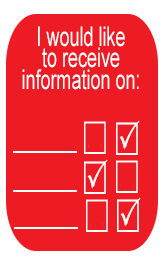
Building a Better Preference Page
Before you can use preference pages to inform your email segmentation and guide your future content investments, you need to give readers a reason to choose their preferences. Building a better form starts with easily understood options and a clear way to choose them. Radio buttons or check boxes are the most familiar designs, and they’re your best choices for a straightforward form. All the options on your preference form should be in a similar format; you don’t want to mix opt-in and opt-out possibilities within the same list.
For example, a form might include options for your weekly newsletter, special notifications, sale notices, webinar information and monthly online magazine. The form might also include an unsubscribe option listed separately to avoid confusion with the many subscription options. Recipients can then tailor the content and email alerts they want to receive without feeling besieged by too much information.
While your preference pages should include all the basics, they can also incorporate other potentially rich data fields to mine. Even something as simple as choosing Mr., Mrs. or Ms can provide valuable information for segmenting your mailing list. Letting readers choose additional contact methods such as social media channels or direct mail on your preference page makes selecting these options convenient for your prospects and useful to you. Adding a few lines of data is fine, but don’t overburden the preference panel; the page should still be fairly brief and shouldn’t feel like a chore to fill out.
Segmentation by Preference
Segmentation matters because it lets you customize messages that target certain members of your global audience more precisely. You achieve greater relevance with proper segmentation, and relevance is key to catching your email recipients’ attention. When you use preference pages, your audience automatically sorts itself into segments for you, giving you an excellent starting point for more directed, focused marketing.
The people who want weekly newsletters may overlap with those who want alerts of upcoming webinars, but they are not quite the same audience. Weekly readers might respond best to email messages that emphasize content while webinar subscribers could find appeals to urgency and direct calls to action more of a motivation. Because your recipients have already self-selected the content they want to receive, you can tailor that content to their needs.
Segmentation Using Other Data
The other information on your preference page is just as important as recipients’ mailing choices. When you ask your recipients about their chosen title, for example, you can segment your email by gender. Location choices help you customize email segments to fit regional needs and preferences. With data about preferred social media channels, you can compile a more complete view of your prospects and potentially connect with them through other venues, reinforcing your marketing message and ensuring that your best customers get the information they want.
Update your preference page and let your customers tell you where they want to be in your email segmentation strategy. You benefit from giving your prospects more relevant information; they benefit by connecting with a company that respects their choices and earns their trust.
Contact our email marketing experts today at 855.867.3224 to help you devise your next email campaign strategy.
© Reach Marketing LLC 2014 All Rights Reserved.






